Alessandra Pluda
In this page I collected a series of event I organized/I am organizing
together with Luca Benatti and Mattia Fogagnolo.
The main idea of these workshops is to gather young and active researchers in Geometric Analysis. They aims at giving an overview of the present research on various aspects of this beautiful subject, with some special attention to the mathematical background and to the motivations.
The location of the workshops is "Centro di Ricerca Matematica De Giorgi - SNS Pisa"
and the events are funded by University of Pisa, SNS Pisa and "Centro di Ricerca Matematica De Giorgi".
Pisan workshop - Ep.V - Geometric Analysis strikes back
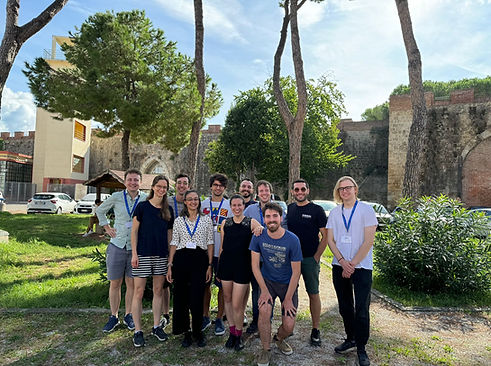
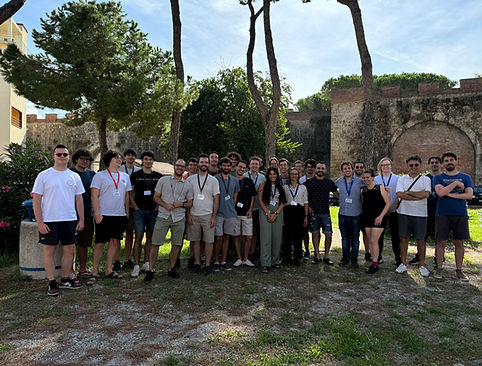
Camillo Brena (Scuola Normale Superiore, Pisa)
Unique continuation for area minimizing currents
Andrea Nützi (Stanford University)
A support preserving homotopy for the de Rham complex with boundary decay estimates
Joshua Daniels-Holgate (Hebrew University of Jerusalem)
Mean curvature flow from conical singularities
Andrea Merlo (Universidad del País Vasco)
On the converse of Pansu’s theorem
Matilde Gianocca (ETH, Zürich)
Morse Index Stability for Harmonic Maps and their Min-Max Construction
Lauro Silini (ISTA)
Characterizing isoperimetric regions in weighted manifolds
Luigi De Masi (Università degli studi di Trento)
Regularity of capillary minimal surfaces
Florian Johne (Albert-Ludwigs-Universität Freiburg)
Positive intermediate curvature and differential forms
Albachiara Cogo (Universtät Tübingen)
Sobolev conformal structures on closed 3-manifolds
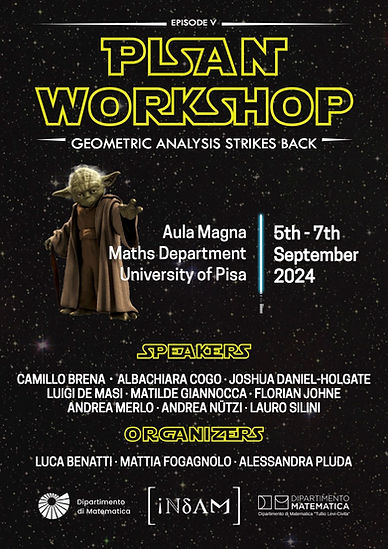
Guess what? A Pisan workshop in Geometric Analysis


Daniele Semola (ETH Zürich)
Ricci Curvature, Fundamental Groups, and the Milnor Conjecture
Chiara Bernardini (Università di Padova)
Existence and asymptotic behaviour of non-normal conformal metrics on ℝ⁴ with sign-changing Q-curvature.
Gianmarco Caldini (Università di Trento)
Generic uniqueness for the Plateau problem.
David Wiygul (Università di Trento)
Uniqueness and Morse index of minimal surfaces in the sphere and ball.
Michele Caselli (Scuola Normale Superiore, Pisa)
Asymptotics of the fractional perimeter and existence of bounded harmonic functions on Riemannian manifolds.
Liangjun Weng (Università di Roma Tor Vergata)
Alexandrov-Fenchel inequality for convex hypersurfaces with capillary boundary in a ball.
Alba Lia Masiello (Università degli studi di Napoli "Federico II")
Estimates for Robin p-Laplacian eigenvalues of convex sets with prescribed perimeter.
Thomas Körber (Universität Wien)
Title: Inverse mean curvature flow and Ricci-pinched three-manifolds.
Marco Pozzetta (Università degli studi di Napoli "Federico II")
Isoperimetry and geometric rigidity on manifolds with nonnegative curvature.
Another Pisan workshop in Geometric Analysis


14th September 2022
Alice Marveggio (Institute of Science and Technology Austria)
Quantitative convergence of the vectorial Allen-Cahn equation towards multiphase mean curvature flow
In its sharp-interface limit, the vectorial Allen-Cahn equation with a potential with N ≥ 3 distinct minima has been conjectured to describe the evolution of branched interfaces by multiphase mean curvature flow. In this talk, we give a rigorous proof for (unconditional) convergence of vectorial Allen-Cahn equation towards multiphase mean curvature flow, assuming that a classical (smooth) solution to the latter exists. Our result is valid for a suitable class of multi-well potentials and in two and three ambient dimensions. For quantitatively well-prepared initial data, we even establish a rate of convergence. Our approach relies on a notion of relative entropy for the vectorial Allen-Cahn equation with multi-well potential and, in particular, on the recent concept of “gradient flow calibrations” for multiphase mean curvature flow.
This is joint work with J. Fischer.
Paolo Bonicatto (University of Warwick)
Transport of currents and geometric Rademacher-type theorems
In the classical theory, given a vector field b on R^d, one usually studies the transportcontinuity equation drifted by b looking for solutions in the class of functions (with certain integrability) or at most in the class of measures. In this seminar I will talk about recent efforts, motivated by the modeling of defects in plastic materials, aimed at extending the previous theory to the case when the unknown is instead a family of k-currents in R^d, i.e. generalised k-dimensional surfaces. The resulting equation involves the Lie derivative Lb of currents in direction b and reads $\partialt Tt + Lb Tt = 0$. In the first part of the talk I will briefly introduce this equation, with a special attention to its space-time formulation. I will then shift the focus to some rectifiability questions and Rademacher-type results: given a Lipschitz path of integral currents, I will discuss the existence of a “geometric derivative”, namely a vector field advecting the currents.
Based on joint work with G. Del Nin and F. Rindler (Warwick).
Luca Benatti (Università di Trento)
Bertie Bott’s every flavour mass concepts in General Relativity
In the big box of Mathematical General Relativity, we can find many different concepts of mass. Among them, the ADM mass is probably the oldest and most famous. From a physical point of view, it gauges the total energy of a space having a specified asymptotic falloff, essentially the one of the Schwarzschild metric. If you want to try a slightly more mathematical flavour, the isoperimetric concept is right for you. It measures the deformation of the space by evaluating the deviation at great distances of the isoperimetric inequality. You might rather add an "energy spice". Then, you can go for a capacity-based definition. In addition to them, there are also quasi-local concepts, such as the Hawking mass. So, which one to choose? How to avoid nasty surprises? In this talk, we aim to organise these concepts, show how they are related, and prove, for some of them, classic theorems, like the Positive Mass Theorem and the Riemannian Penrose Inequality. This is a work in preparation, in collaboration with M. Fogangolo and L. Mazzieri.
Mario Santilli (Università dell'Aquila)
Curvature measures and soap bubbles beyond convexity
The celebrated uniqueness results of Alexandrov (1958) and Korevaar-Ros (1988) characterize the ball as the smooth bounded domain whose k-th mean curvature is constant for some k = 1, ...., n. A classical and important task in geometry is to provide extensions of these results in presence of singularities. Replacing the classical pointwise mean curvature functions by the curvature measures, Diskant (1968), for the gaussian curvature, and Schneider (1979) , for all curvature meaures, obtained these characterizations for arbitrary convex bodies. In this talk we present a result that extends the results of Diskant and Schneider beyond the convex regime, obtaining these characterizations for sets of positive reach. Joint work with Daniel Hug.
Anna Kubin (Politecnico di Torino)
Direct minimization of the Canham–Helfrich energy on generalized Gauss graphs
Given a smooth two-dimensional manifold M oriented by a unit normal field n, the Gauss graph of M is the graph of the Gauss map n. Exploiting the fact that the curvatures of M are coded in its Gauss map, Anzellotti, Serapioni and Tamanini 2 generalized the notion of Gauss graph of a manifold and developed the theory of generalized Gauss graphs. In 1 we prove the existence of minimizers of the Canham-Helfrich functional in the setting of generalized Gauss graphs. As a first step, we extendthe Canham-Helfrich functional, usually defined on regular surfaces, to generalized Gauss graphs, then we prove lower semicontinuity and compactness undera suitable condition on the bending constants ensuring coerciveness; the minimization follows by the direct methods of the Calculus of Variations. Finally, we present remarks on the regularity of minimizers and on the behavior of thefunctional in case there is lack of coerciveness.
References
1 A. Kubin, L. Lussardi and M. Morandotti, Direct minimization of the Canham-Helfrich energy on generalized Gauss graphs, preprint 2022.
2 G. Anzellotti, R. Serapioni and I. Tamanini, Curvatures, functionals, currents, Indiana Univ. Math. J., 39(3):617-669, 1990.
15th September 2022
Davide Carazzato (Scuola Normale Superiore di Pisa)
On some boundedness and symmetry results for the minimizers of a non-local energy
In this seminar I will talk about a wide class of non-local energies that are defined on the Radon measures of R^N. After introducing briefly the literature, I will focus on some new results. I will treat the symmetry of the minimizers, that is closely related to the convexity of the energy.
Then I will pass to the regularity results for the minimizers, that are connected to the previous topic: it is possible to obtain an L^infty bound for the radial minimizers if the concentration of the mass is strongly penalized.
This talk is based on a paper in collaboration with Aldo Pratelli.
Mario Schulz (Westfälische Wilhelms-Universität Münster)
Free boundary minimal surfaces in the unit ball
Free boundary minimal surfaces arise naturally in partitioning problems for convex bodies and capillarity problems for fluids. The case of the Euclidean unit ball as ambient manifold for free boundary minimal surfaces is of particular interest for the study of extremal metrics for Steklov eigenvalues on surfaces with boundary. The theory has been developed in various interesting directions, yet many fundamental questions remain open. Two of the most basic ones can be phrased as follows: (1) Can a surface of any given topology be realised as an embedded free boundary minimal surface in the 3-dimensional Euclidean unit ball? We answer this question affirmatively for surfaces with connected boundary and arbitrary genus. (2) When they exist, are such embeddings unique up to ambient isometry? We answer this question in the strongest negative terms by providing pairs of non-isometric free boundary minimal surfaces with the same topology and symmetry group.

From left to right:
first row - the girls: Alessandra Pluda, Alice Marveggio, Anna Kubin
second row - the boys: Davide Carazzato, Luca Benatti, Paolo Bonicatto, Mario Schulz, Mario Santilli, Mattia Fogagnolo
A Pisan workshop in Geometric Analysis
was held at Centro di Ricerca Matematica De Giorgi (Pisa), the 13th and 14th of October.
The workshop took place in hybrid mode, all the speaker were present in person.
It was organised by Mattia Fogagnolo (Centro di Ricerca Matematica De Giorgi - SNS Pisa)
and me.
For more information see the webpage: http://crm.sns.it/event/492/index.html#title
Youtube video: first day and second day
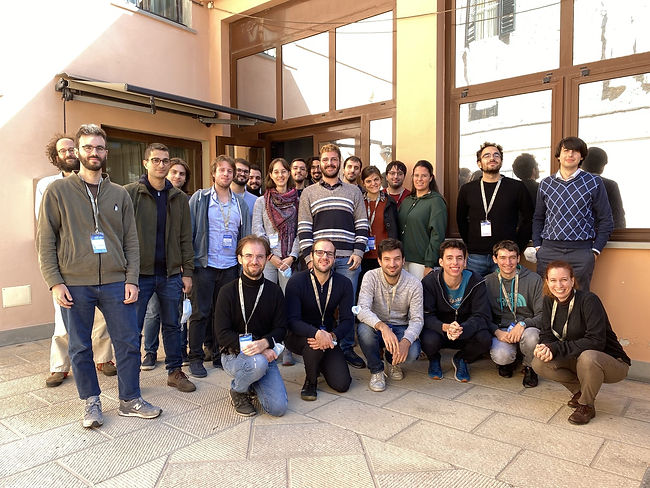
Speakers:
Stefano Borghini (Milano Bicocca)
On the characterization of the static spacetimes.
Static spacetimes are solutions to the Einstein Field Equations featuring a very special metric structure (warped product). Such a structure induces a natural foliation of the spacetime into space-like slices which are all isometric to each other, so that the corresponding physical universe is static. We discuss the problem of the classification of such spacetimes, reviewing the main known results and distinguishing between the cases of positive, negative and zero cosmological constant. We then show how a recent comparison argument can be applied to prove some known and new characterizations of the model solution.
Giulio Colombo (Università degli Studi di Milano)
Gradient bounds for the minimal graph equation on Riemannian manifolds.
In this talk we consider the problem of establishing local and global gradient bounds for positive solutions of the minimal graph equation on complete Riemannian manifolds with Ricci curvature bounded below. We show that any entire positive solution u on a complete manifold with Ric ≥ -k^2, with k in [0,+\infty), satisfies the bound \sqrt(1+Du2) ≤ e^(k u), hence we deduce a Liouville theorem for the minimal graph equation on complete manifolds with Ric ≥ 0, also proved by Ding (2019) by different means. On manifolds with Ric ≥ 0 and sectional curvature (Sect) bounded from below by a negative constant, we also show that entire solutions with negative part of linear growth have globally bounded gradient, improving on recent results by Rosenberg, Schulze, Spruck (2013) and Ding, Jost, Xin (2016). As a consequence, we prove that a complete manifold M with Sect ≥ 0 supporting a nonconstant minimal graphic function of linear growth splits isometrically as a Riemannian product M = Rx M0. We also discuss different conditions, weaker than Sect ≥ 0, still ensuring splitting of tangent cones at infinity for complete manifolds with Ric ≥ 0 supporting nonconstant minimal graphic functions with bounded gradient. The results presented here are based on joint works with M. Magliaro, L. Mari, M. Rigoli and E. S. Gama.
Gianmichele Di Matteo (Karlsruhe)
CMC and isoperimetric small double bubbles in compact manifolds
In this talk, we will show how CMC and isoperimetric sets enclosing and separating two different small volumes in a manifold, arise as small perturbations of Euclidean standard double bubbles. These latter were shown to be isoperimetric minimizers given two fixed volumes by Hutchings, Morgan, Ritoré and Ros. Due to the singular nature of the model minimizer, the perturbations considered contain a non-trivial tangential component. The proof is based on elements from oscillation theory for degenerate elliptic operators, Hodge theory for overdetermined non-elliptic problems and perturbation theory.
Giada Franz (ETH Zurich)
Equivariant min-max theory to construct free boundary minimal surfaces in the unit ball
A free boundary minimal surface (FBMS) in the three-dimensional Euclidean unit ball is a critical point of the area functional with respect to variations that constrain its boundary to the boundary of the ball (i.e. the unit sphere). A very natural question is whether there are FBMS in the unit ball of any given genus and number of boundary components. A powerful tool to construct minimal surfaces (both in the case without and with boundary) is the Almgren-Pitts min-max theory developed in the last 50 years. In this talk we present an equivariant version of this procedure and we use it to construct and study a new family of FBMS with connected boundary and any given genus in the unit ball.
Federico Glaudo (ETH Zurich)
From a higher order isoperimetric inequality for non-convex domains to an exotic functional inequality
One of the Alexandrov-Fenchel inequalities states that, among convex domains K⊂
R^n with perimeter equal to the perimeter of the ball, the quantity \int_∂K H is minimized by the ball (H denotes the mean curvature of the boundary). This is a higher-order isoperimetric inequality: instead of comparing volume and perimeter, we are comparing perimeter and integral of the mean curvature. The validity of the inequality is open for mean-convex (i.e., H greater or equal 0) domains.
We will consider the inequality without the assumption of mean-convexity, but replacing H with its absolute value and restricting our study to domains K which are C^1-perturbations of the ball. Under these assumptions, we will explain why the desired inequality is "morally" equivalent to the following functional inequality: given
u: S^{n-1}→R with ||u|| C^1 sufficiently small, it holds
\int (∆u) ∇u^2 ≤ (n-2)/(n-1)(sup ∆u)\int ∇u^2. Thanks to this insight, one can prove the inequality in some special cases.
Fritz Hiesmayr (Centro di Ricerca Matematica Ennio De Giorgi, Scuola Normale Superiore)
The Allen-Cahn equation and minimal surfaces
The Allen-Cahn equation is a semilinear elliptic PDE modelling phase transitions. It depends on a small parameter: as this goes to zero its solutions accumulate near minimal surfaces, in a certain weak sense. In this talk I want to discuss some of the mechanisms underlying this phenomenon. The focus will be on variational aspects of the problem, and the Morse index in particular. The eventual aim is to present some results concerning low-energy solutions in the round three-sphere.
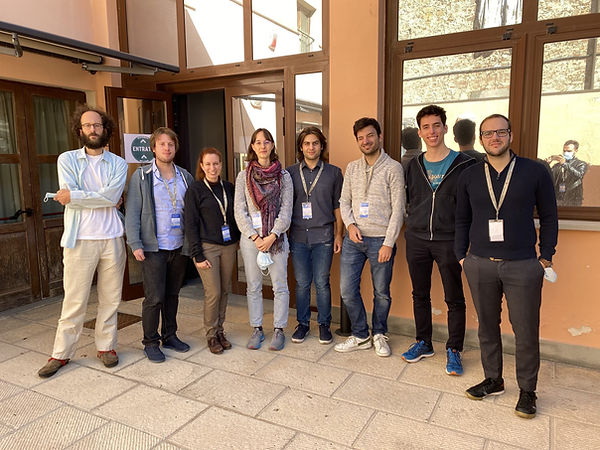
From left to right: Fritz Hiesmayr, Mattia Fogagnolo, Alessandra Pluda, Giada Franz, Giulio Colombo, Stefano Borghini, Federico Glaudo, Gianmichele Di Matteo
Workshop
"Online workshop in Geometric Analysis"
December 15th-17th 2020, Università di Pisa & Scuola Normale Superiore di Pisa
Co-organized with Mattia Fogagnolo

15th December '20
Alberto Roncoroni (Universidad de Granada)
Serrin’s type problems in Riemannian manifolds
The talk deals with overdetermined elliptic boundary value problems for bounded domains in Riemannian manifolds. Starting from the well-known Serrin’s rigidity result we will consider its counterpart in space forms (the hyperbolic space and the hemisphere). Then we will consider Serrin’s type problems in more general Riemannian manifolds. In particular we will show rigidity results for overdetermined problems in the so-called warped product manifolds. This is based on a joint work with Alberto Farina.
Ekaterina Mukoseeva (University of Helsinki)
The sharp isocapacitary inequality: the case of p-capacity
It is well-known that the smallest p-capacity among sets of a given volume is achieved solely by balls. A natural question to ask is whether the balls are stable minimizers. That is, supposing a set has almost the p-capacity of a ball with the same volume, is it quantitatively close to it? The first result to our knowledge was given by Fusco, Maggi, and Pratelli in 2009. However, the estimate they provide is not sharp. In this talk we discuss the sharp quantitative stability of the balls for p-capacity. The proof combines the Selection Principle, introduced by Cicalese and Leonardi in 2012, with the regularity theory for free boundary problems established by Danielli and Petrosyan in 2005. This is a generalization of a joint work with Guido De Philippis and Michele Marini, where we got the sharp isocapacitary inequality for p = 2.
16th December '20
Ilaria Mondello (Université de Paris-Est Créteil)
Limits of Riemannian manifolds with a bound on the Kato constant
The structure of non-collapsed limits of manifolds with a uniform lower bound on the Ricci curvature is now well known, thanks to the work of many mathematicians, Anderson, Cheeger, Colding, Tian, Naber, Jiang. In this talk, we discuss the study of limits of manifolds with a weaker integral condition on the Ricci curvature. After introducing this condition and the definition of Kato limits, we show that non-collapsed Kato limits carry a stratification similar to the one of Ricci limits and RCD spaces. This is a joint work with Gilles Carron (Universite de Nantes) and David Tewodrose (Université Libre de Bruxelles).
Alessandro Pigati (Courant Institute of Mathematical Sciences, NYU)
Codimension two area and Yang-Mills-Higgs
While the calculus of variations of the area of hypersurfaces is becoming more and more understood, with recent developments in the construction of unstable critical points, little is known for higher codimension. In this talk we present an approach to the codimension two, based on the Yang-Mills-Higgs energy for Hermitian line bundles, in the self-dual case. This functional, which is well known in gauge theory, turns out to be a good relaxation of the (codimension two) area functional, in a similar way as the Allen-Cahn functional in codimension one: in joint work with Daniel Stern we show that, if one uses scalings which preserve the self-duality, the energy of critical points concentrates along a minimal variety. We also discuss the corresponding Gamma-convergence theory, which is joint work with Daniel Stern and Davide Parise.
17th December '20
Fabian Rupp - (Universität Ulm)
The volume-preserving Willmore flow
For an immersed surface in R^3, we study the L^2-gradient flow of the Willmore energy subject to a volume constraint. Despite its nonlocal nature, we show that the flow can be controlled by the concentration of curvature. This is used to prove a lower bound on the existence time, which enables us to construct a blow-up as it was done by Kuwert and Sch ̈atzle for the Willmore flow. With the help of a constrained Lojasiewicz–Simon inequality and a classification result for the concentration limit we show convergence to a round sphere if the initial energy is below 8π.
Marco Pozzetta (Università di Pisa)
On the smooth convergence of geometric flows
In this talk we consider extrinsic geometric energies, i.e., functionals F defined on smooth immersions φ : M → R^n of a given manifold M depending on extrinsic geometric quantities (such as the second fundamental form, the mean curvature, derivatives of those, ...) such that F is invariant w.r.t. diffeomorphisms of M. Then an extrinsic geometric flow is a smooth family of immersions φ_t : M → R^n, for t ∈ [0,T), such that a given extrinsic geometric energy F evaluated on φ_t decreases in time by some assigned evolution equation.
If such a geometric flow φ_t is defined for any positive time, i.e., T = +∞, we are interested in the existence of a limit smooth immersion φ_∞ of φ_t as t → +∞. In such a case, we say that the flow smoothly converges. In this talk we discuss a strategy for promoting the sub-convergence of such a flow, that is the existence of a limit up to isometries of R^n and on suitable diverging sequences tn, into the smooth convergence of the flow. In the discussion we analyze the explicit example of the L^2-gradient flow of the energy
F_m(φ) := \int_M 1 + |∇^mν|^2 dμ,
where φ : M^n → R^(n+1) is an immersed closed hypersurface, ν is a (locally defined) unit normal vector,
∇ the covariant derivative, μ the volume measure, and m > n/2 is integer. The strategy of the proof is based on the application of a Lojasiewicz–Simon gradient inequality.We discuss how same argument can be applied also for deducing the smooth convergence of the L^2-gradient flow of the elastic energy of closed curves in R^n, and of the (L^p, L^p′ )-gradient flow of the p-elastic energy of closed curves immersed in arbitrary Riemannian manifolds (M , g) for p ∈ [2, +∞).
Part of the results discussed in this talk are obtained in collaboration with Carlo Mantegazza (Università Federico II di Napoli & Scuola Superiore Meridionale).